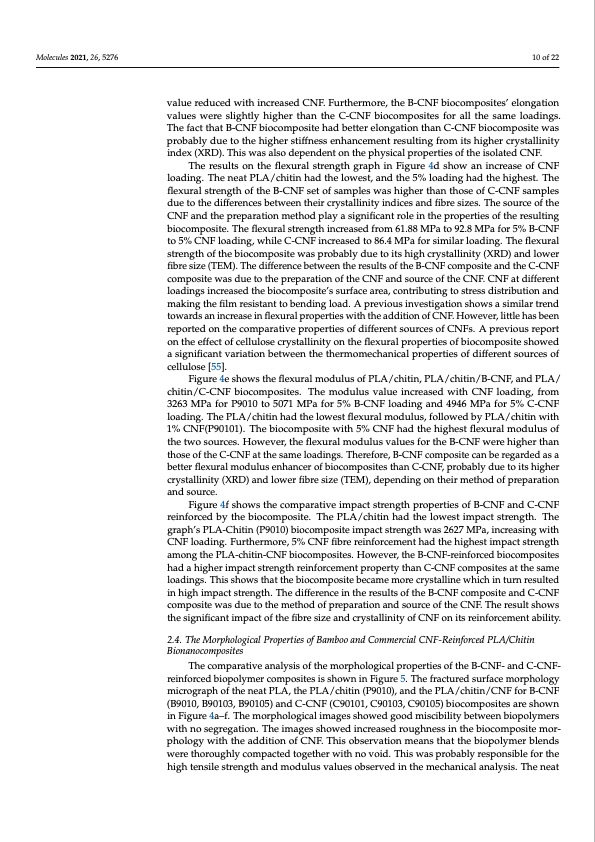
PDF Publication Title:
Text from PDF Page: 010
Molecules 2021, 26, 5276 10 of 22 value reduced with increased CNF. Furthermore, the B-CNF biocomposites’ elongation values were slightly higher than the C-CNF biocomposites for all the same loadings. The fact that B-CNF biocomposite had better elongation than C-CNF biocomposite was probably due to the higher stiffness enhancement resulting from its higher crystallinity index (XRD). This was also dependent on the physical properties of the isolated CNF. The results on the flexural strength graph in Figure 4d show an increase of CNF loading. The neat PLA/chitin had the lowest, and the 5% loading had the highest. The flexural strength of the B-CNF set of samples was higher than those of C-CNF samples due to the differences between their crystallinity indices and fibre sizes. The source of the CNF and the preparation method play a significant role in the properties of the resulting biocomposite. The flexural strength increased from 61.88 MPa to 92.8 MPa for 5% B-CNF to 5% CNF loading, while C-CNF increased to 86.4 MPa for similar loading. The flexural strength of the biocomposite was probably due to its high crystallinity (XRD) and lower fibre size (TEM). The difference between the results of the B-CNF composite and the C-CNF composite was due to the preparation of the CNF and source of the CNF. CNF at different loadings increased the biocomposite’s surface area, contributing to stress distribution and making the film resistant to bending load. A previous investigation shows a similar trend towards an increase in flexural properties with the addition of CNF. However, little has been reported on the comparative properties of different sources of CNFs. A previous report on the effect of cellulose crystallinity on the flexural properties of biocomposite showed a significant variation between the thermomechanical properties of different sources of cellulose [55]. Figure 4e shows the flexural modulus of PLA/chitin, PLA/chitin/B-CNF, and PLA/ chitin/C-CNF biocomposites. The modulus value increased with CNF loading, from 3263 MPa for P9010 to 5071 MPa for 5% B-CNF loading and 4946 MPa for 5% C-CNF loading. The PLA/chitin had the lowest flexural modulus, followed by PLA/chitin with 1% CNF(P90101). The biocomposite with 5% CNF had the highest flexural modulus of the two sources. However, the flexural modulus values for the B-CNF were higher than those of the C-CNF at the same loadings. Therefore, B-CNF composite can be regarded as a better flexural modulus enhancer of biocomposites than C-CNF, probably due to its higher crystallinity (XRD) and lower fibre size (TEM), depending on their method of preparation and source. Figure 4f shows the comparative impact strength properties of B-CNF and C-CNF reinforced by the biocomposite. The PLA/chitin had the lowest impact strength. The graph’s PLA-Chitin (P9010) biocomposite impact strength was 2627 MPa, increasing with CNF loading. Furthermore, 5% CNF fibre reinforcement had the highest impact strength among the PLA-chitin-CNF biocomposites. However, the B-CNF-reinforced biocomposites had a higher impact strength reinforcement property than C-CNF composites at the same loadings. This shows that the biocomposite became more crystalline which in turn resulted in high impact strength. The difference in the results of the B-CNF composite and C-CNF composite was due to the method of preparation and source of the CNF. The result shows the significant impact of the fibre size and crystallinity of CNF on its reinforcement ability. 2.4. The Morphological Properties of Bamboo and Commercial CNF-Reinforced PLA/Chitin Bionanocomposites The comparative analysis of the morphological properties of the B-CNF- and C-CNF- reinforced biopolymer composites is shown in Figure 5. The fractured surface morphology micrograph of the neat PLA, the PLA/chitin (P9010), and the PLA/chitin/CNF for B-CNF (B9010, B90103, B90105) and C-CNF (C90101, C90103, C90105) biocomposites are shown in Figure 4a–f. The morphological images showed good miscibility between biopolymers with no segregation. The images showed increased roughness in the biocomposite mor- phology with the addition of CNF. This observation means that the biopolymer blends were thoroughly compacted together with no void. This was probably responsible for the high tensile strength and modulus values observed in the mechanical analysis. The neatPDF Image | Supercritical Carbon Dioxide Isolation of Cellulose Nanofibre

PDF Search Title:
Supercritical Carbon Dioxide Isolation of Cellulose NanofibreOriginal File Name Searched:
molecules-26-05276-v2.pdfDIY PDF Search: Google It | Yahoo | Bing
Sulfur Deposition on Carbon Nanofibers using Supercritical CO2 Sulfur Deposition on Carbon Nanofibers using Supercritical CO2. Gamma sulfur also known as mother of pearl sulfur and nacreous sulfur... More Info
CO2 Organic Rankine Cycle Experimenter Platform The supercritical CO2 phase change system is both a heat pump and organic rankine cycle which can be used for those purposes and as a supercritical extractor for advanced subcritical and supercritical extraction technology. Uses include producing nanoparticles, precious metal CO2 extraction, lithium battery recycling, and other applications... More Info
| CONTACT TEL: 608-238-6001 Email: greg@infinityturbine.com | RSS | AMP |